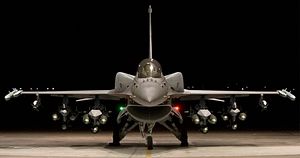Taiwan is considering procuring an unknown number of U.S-made fighter jets to boost its defense capabilities vis-à-vis the People’s Republic of China, the country’s Ministry of National Defense announced last week.
The ministry requested fighter jets from the United states to “demonstrate our determination and ability to defend ourselves,” according to Deputy Defense Minister Shen Yi-ming.
The U.S. has not officially responded to the request and the ministry neither specified an exact number of aircraft to be procured nor the model. A ministry spokesperson did not rule out for the government to once more request the F-35B, the U.S. Marine Corps’ short take-off and vertical landing (STOVL) variant of Lockheed Martin’s supersonic fifth-generation fighter jet.
According to unconfirmed Taiwanese media reports, the Republic of China Air Force (ROCAF) had expressed interest in procuring up to 66 Lockheed Martin F-16 Fighting Falcon Viper (V) Block 70 multirole combat aircraft. F-16V fighters are equipped with an Active Electronically Scanned Array (AESA) radar system, upgraded avionics, and a high-volume, high-speed data bus, among other things.
Notably, Taiwan is in the process of upgrading its F-16 A/B fleet to the F-16V variant. The first four retrofitted F-16A/B fighters, upgraded by Taiwan’s state-owned Aerospace Industrial Development Corporation (AIDC), were handed over to ROCAF at an airbase in Chiayi county in southwestern Taiwan in October 2018.
The program, codenamed Phoenix Rising Project, was launched in 2016 with the purpose of upgrading 144 ROCAF A/B Fighting Falcon combat aircraft to the F-16V configuration by 2023. AIDC is Lockheed Martin’s local project partner. Overall cost for the Phoenix Rising Project is estimated at around $5.3 billion. As I reported last year:
Initially, the first upgraded batch of F-16Vs was to consist of 10 aircraft. However, delays in software testing in the United States reduced the number to four. Approximately 25 to 28 aircraft are expected to undergo modernization each year until 2023. The remaining three aircraft of the first batch are slated for delivery by the end of 2018. Two ROCAF F-16 A/Bs were already upgraded to the F-16V standard in the United States. In October 2015, the first of these upgraded ROCAF F-16 fighter jet in its V configuration conducted its maiden flight in Fort Worth, Texas.
The Phoenix Rising Project also foresees the procurement of additional beyond-visual-range (BVR) air-to-air missiles form the U.S., as well as domestically-produced weapons systems such as the soon to be operationalized Sky Sword II medium-range air-to-air missile 空劍二飛彈 or Sky Sword.
“Taiwan’s F-16 fleet is equipped with the AIM-9 Sidewinder, a short-range air-to-air missile and the [BVR] AIM-120 Advanced Medium-Range Air-to-Air Missile, or AMRAAM,” I wrote last year. “Of the latter, Taiwan has a stockpile of a little over 300, which yields a ratio of around 2 AMRAAMs per F-16.”
ROCAF fighter jets are highly vulnerable to destruction on the ground by People’s Liberation Army Air Force (PLAAF) aircraft or missiles in the event of a conflict. As I explained previously, given Taipei’s relatively modest defense expenditures, it may be better to invest in other weapons systems to militarily deter Beijing (See: “Why Selling F-35s to Taiwan Is a Terrible Idea”).































